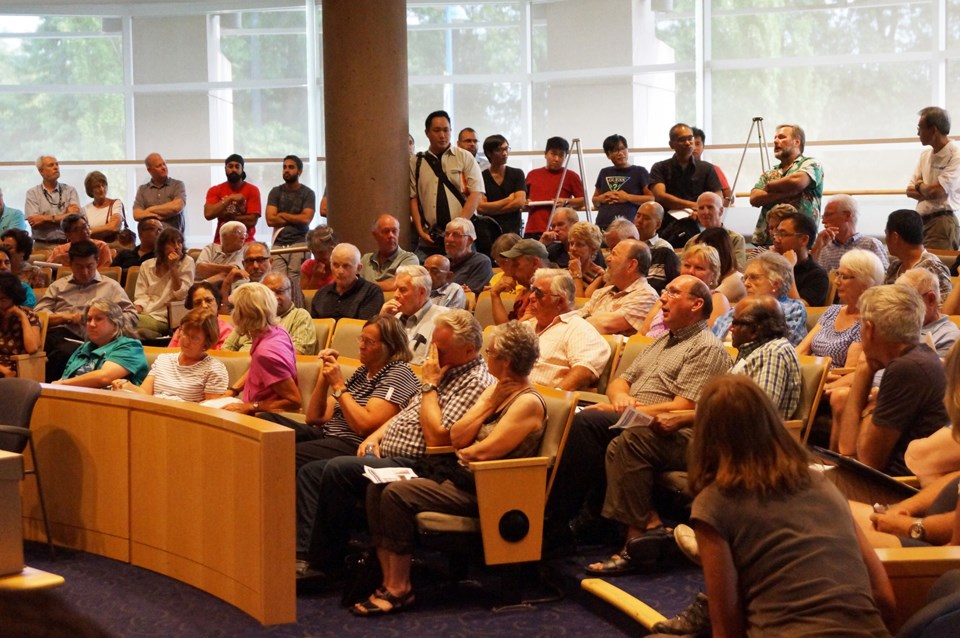Richmond City Council has tentatively approved a new set of bylaws aimed at reducing the size of homes. However, the decision at city hall on Monday was met with opposition from some residents as well as two councillors, one of whom called the process “half-assed.”
The amendment to the city’s existing residential zoning bylaws will now go to a public hearing on Sep. 8. If approved, it will mean Richmond will still have the tallest homes in the Metro Vancouver region, as well as the most generous ceiling heights when it comes to calculating the size of homes and how they push up against existing properties.
Prior to discussion on the matter council approved the subdivision of a residential lot at 11811 Dunford Road in Steveston, in which Coun. Derek Dang, a developer, had to briefly remove himself from the chambers granted he owns the property.
Upon returning Dang joined Mayor Malcolm Brodie and fellow councillors Bill McNulty, Linda McPhail, Chak Au, Ken Johnston and Alexa Loo in voting for amendments that went against the advice of city planners.
Initially, at a planning committee meeting last week, councillors Harold Steves and Carol Day had tentatively voted in favour of relaxing the staff-proposed restrictions on side setbacks for medium sized lots, as suggested by builders and developers. However, at the council level they decided otherwise and voted for the greater setbacks, as recommended by staff. They also voted against allowing higher ceiling heights (Five metres as opposed to 3.7 metres) before the city counts the open space twice against the allowable size of a home.
Realtor Brianna Chu of Royal Pacific Realty explained in a statement to council that homes with higher ceilings sell better.
Furthermore, “Richmond is considered a higher end, prestige (sic) area for new immigrants. They like to invest here because of what we have — the restaurants, the convenience to the airport, the shopping malls.”
Builder Samuel Yau, as well as builder and realtor Raman Kooner expressed similar concerns that restricting home sizes will result in lower home prices.
In reply to Day comparing various aspects of Richmond’s bylaw to other cities, Kooner noted Richmond has lower allowable floor area ratios (FAR represents the size of a home's livable space compared to the size of a lot) than other municipalities in part because there are no basements.
Longtime resident John Roberts stated the issue at heart was how new homes are destroying green space and overshadowing older homes, not what is or is not allowable floor space.
Realtor Lyn Terborg, of the Westwind Ratepayers’ Association, told council that she thought the changes would provide “no relief” to the “massing” of homes. She stated that the changes would only result in more three-storey homes, which would still be allowed to reach 10.5 metres in height.
Meanwhile fellow longtime resident Calvin Lee opined that he should be able to build his “dream house” and that if homes were restricted too much he would consider moving.
As if to cross-examine him, Day asked Lee where he would move granted other municipalities have tighter restrictions on various zoning aspects.
Au said he supported the higher ceilings because the option recommended by staff meant lower ceilings but with a 15 square-metre bonus ceiling, which would not count against a home’s FAR. Au said that bonus would lead to massing, although a staff report noted its effects would be mitigated. However, there was another option on the table from staff — low ceilings (3.7 metres) and no bonus — that Au did not mention.
Meanwhile Day preferred staff’s option with the bonus ceiling. She called on council to favour what city planners had recommended:
“It does not fix a broken leg, it puts a Band-Aid on it. And rather than make a half-assed effort to deal with (building) massing I would suggest we go with staff recommendations,” said Day, further noting a planned one-year review of the changes would only add to the problem.
Gavin Woo, the city’s senior manager of building approvals, estimated 80 per cent of the roughly 400 homes that are being torn down and rebuilt each year would likely use the higher ceilings.
As such Steves said he was convinced the city ought to lower them to come in line with other cities.
“The more I hear about the bylaw the more I’m concerned,” said Steves, noting large homes show a “lack of respect” to existing residents.
“People aren’t welcomed in their own neighbourhood and that’s really what’s happening.”
After one builder, Ivan Krpan, noted existing bylaw infractions were the result of a minority of builders Steves told staff to start revoking business licenses.
Loo said she thought the bylaw amendments agreed to by the majority of council did bring massing down and she agreed with Steves on the need for better enforcement.
McPhail said it was evident that “boundaries have been pushed” by builders.
Last week McNulty, who tabled the motion against the staff recommendation at the committee level, said any decision was not going to please everyone and compromises must be made.
Dang and Johnston did not speak on the issue.



